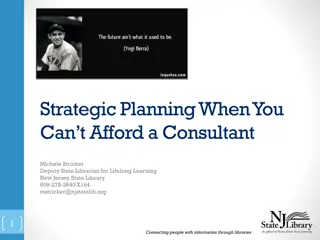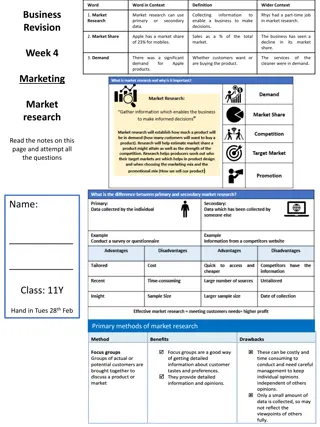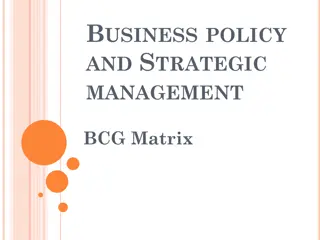Strategic Market Planning Essentials
Strategic market planning is vital for businesses as it guides decision-making and goal-setting at various levels. It involves composing the big picture, integrating strategic, functional, and operational plans, and following steps like defining the mission, evaluating the environment, and setting objectives aligned with the organizational mission. Strategic planning optimizes revenues and minimizes risks in a dynamic market environment.
Uploaded on Oct 10, 2024 | 0 Views
Download Presentation

Please find below an Image/Link to download the presentation.
The content on the website is provided AS IS for your information and personal use only. It may not be sold, licensed, or shared on other websites without obtaining consent from the author.If you encounter any issues during the download, it is possible that the publisher has removed the file from their server.
You are allowed to download the files provided on this website for personal or commercial use, subject to the condition that they are used lawfully. All files are the property of their respective owners.
The content on the website is provided AS IS for your information and personal use only. It may not be sold, licensed, or shared on other websites without obtaining consent from the author.
E N D
Presentation Transcript
Lecture 3 Strategic Market Planning
Planning: Compose the Big Picture Planning is everything almost! Business planning is an ongoing process that guides short- and long-term decisions. Helps identify and build on firm strengths Improves managerial decision making Develops objectives and provides a means of charting progress toward goals
Business Planning: An Integrated Activity Strategic, functional, and operational plans must be in harmony for firm to succeed. Planning at all levels flows from organizational mission. Planners at all levels must keep the big picture in mind. Strategic planning plays an important role in the modern corporation. Optimize revenues across multiple lines of business. Minimize risk in a complex and changing global environment. Includes a series of steps that results in development of growth strategies.
Step 1: Define the Mission Key questions in determining mission: What business are we in? What customers should we serve? How should we develop the firm s capabilities and focus its efforts? A mission statement is a formal document that describes the firm s overall purpose and what it hopes to achieve in terms of its customers, products, and resources. Twitter s mission statement is To give everyone the power to create and share ideas and information instantly, without barriers. The ideal mission statement is not too Broad Narrow Shortsighted
Step 2: Evaluate the Environment Examination of internal and external environments Managers often synthesize environmental analysis into a format known as SWOT analysis. SWOT analysis catalogs firms internal strengths and weaknesses and external opportunities and threats. Internal environment consists of controllable elements within firm. Key technologies Patents Financial stability Supplier relationships Reputation Human capital External environment consists of factors outside the firm. Economy Competition Technology trends Sociocultural trends Legal/political/ethical trends
Step 3: Set Organizational or SBU Objectives Organizational goals and objectives should be direct outgrowth of the mission statement. Taking into account internal and external environmental factors Objectives should be specific, measureable, attainable, and sustainable. May be directed toward financial- , operational- , or customer-based criteria
Step 4: Establish Business Portfolio BCG Matrix A business portfolio represents the range of different businesses that a large firm operates. Disney operates multiple lines of business, including movie studios, theme parks, cruises, etc. Portfolio analysis: Assesses the growth potential for a firms SBUs and product lines BCG Growth-Share Matrix
Step 5: Develop Growth Strategies Product Market Growth Matrix Product-market growth matrix Characterizes different types of growth strategies based on market and product types. Market penetration Market development Product development Diversification
Self Assessment Exercise Spend some time to determine the following: If USC Upstate is a business and each degree it offers is a SBU, Develop the business portfolio for the following degrees: Biology Psychology Political Science Mathematics Sociology Art Studio (Graphic Design) Business Administration and Economics Chemistry Computer Information Systems Engineering Technology Management Health Information Management Nursing - Bachelor of Science (B.S.N.) Criminal Justice English History Theatre
Action Plans Assigning Responsibility in the Action Plan Not everybody involved will be marketers Sales, Production, Quality control, Shipping, Customer service, Finance, IT Creating Action Plan Timelines Each action plan requires a time line needed to accomplish the various tasks Often portrayed in flowchart form to help visualize sequence of tasks Setting a Budget Each cost element of the plan should link to a budget item Increases accountability for all parties involved with implementing the marketing plan Accuracy in estimating individual action plan expenditures helps budget forecasting. Measurements and Controls Marketing control is a formal process for: Measuring performance Comparing performance to established marketing and strategy objectives Making adjustments to the objectives or strategies based on this analysis























